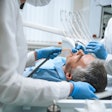Female dentists focus more rigorously on caries prevention than do their male counterparts, according to a study in the Journal of the American Dental Association (April 2011, Vol. 142:4, pp. 429-440).
The study, conducted at the University of Florida, is one of the first to examine the differences in clinical decision-making patterns between male and female dentists, the researchers noted. Given that the proportion of women to men in dentistry has shifted in recent years, with women accounting for 12% of practicing dentists in 1990 and roughly 22% in 2010, they hypothesized that there might be a parallel shift occurring in practice patterns.
"Scientific findings have supported a shift among dental practitioners toward greater use of prevention and more conservative management of caries," the study authors wrote. "Considering that on average, female dentists are younger and are more recent graduates, we would expect to find that, as a group, they may be using more caries prevention and a more conservative management approach to caries consistent with current recommendations."
The researchers surveyed the practice habits of 390 male and 73 female general dentists in the U.S. who were members of the Dental Practice-Based Research Network (DPBRN). Study participants and responded to questions regarding their practices, patients' traits, prevention, and caries assessment. A 15-day pilot study of 35 dentists tested comprehension of the questions asked.
Statistical models were adjusted for a number of criteria: dental school graduation date, practice model, full-time versus part-time practitioner, and whether they were owners or employees.
Among the study findings:
In comparison with male dentists, female dentists had graduated from dental school more recently (p < 0.001) and were more likely to be working part time (p = 0.002). However, when only full-time dentists were considered, the researchers found no differences in the number of patients seen each week by male and female dentists.
Male and female dentists were distributed equally across the three practice models, but female dentists were less likely to be practice owners or partners (p < 0.001).
The researchers found no difference between male and female dentists in the number of days for which their patients waited for examination or treatment appointments.
Female dentists treated a significantly larger proportion of pediatric patients than did male dentists (p < 0.001).
There were no differences between male and female dentists in the percentage of time they spent on restorative treatment, the fees they charged for a two-surface amalgam restoration, or the percentage of their patients who had dental insurance.
"We found that female dentists who were members of the DPBRN had a greater preference than did male dentists for individualized caries-preventive regimens and are more likely to recommend at-home fluoride treatments for both pediatric and adult patients," the study authors noted. "Female dentists also took a more conservative approach, choosing to restore interproximal lesions at a later stage of their development and preferring to use preventivetherapy at earlier stages."



















